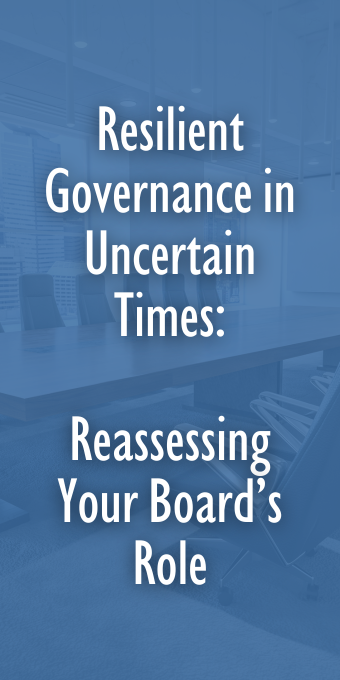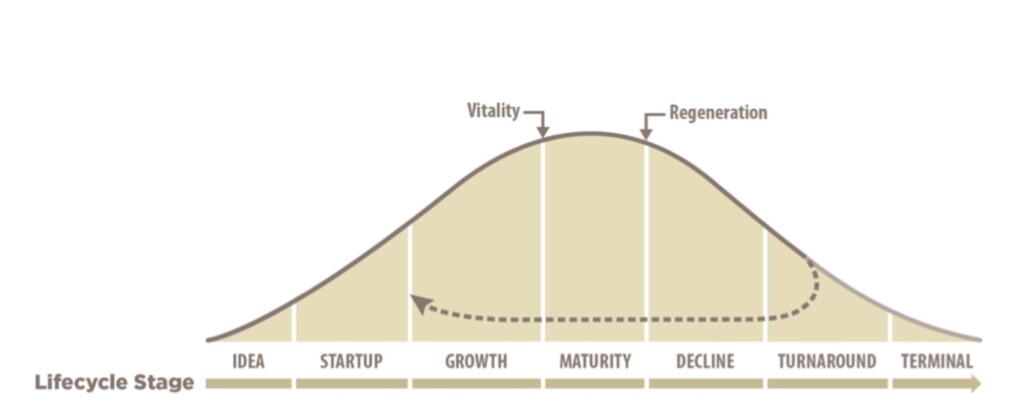Resilient Governance in Uncertain Times: Reassessing Your Board’s Role
Nonprofits are no strangers to pressure, but today’s challenges — political volatility, funding uncertainty, and social polarization — are putting new and urgent demands on boards of directors. In this context, good governance isn’t just about growth or planning for the future. It’s about ensuring stability, protecting mission integrity, and providing strong leadership through disruption.
Now more than ever, boards need to understand their essential responsibilities and reassess whether they are structured and supported to meet this moment.
Understanding the Nonprofit Lifecycle to Diagnose Board Needs
The Nonprofit Lifecycles framework1 provides a helpful lens to understand how governance must evolve during periods of instability. Organizations don’t always move forward smoothly through stages of growth and vitality. Many find themselves in turbulence, decline, or even turnaround phases — each of which requires distinct board responses. These are not signs of failure, but critical junctures that call for intentional leadership.
- Boards supporting organizations in Turnaround must often disrupt old patterns — reinvigorating board culture, rotating out legacy members who are no longer actively contributing, and recruiting new voices to bring fresh energy and direction.
- In Decline or Crisis stages, the board’s role becomes more intensive. Directors may need to step into an active leadership posture — managing risk, engaging with key stakeholders, and helping to reestablish trust and credibility.
Even organizations that appear stable on the surface may be facing unseen stressors. Rapid political shifts, economic volatility, or internal misalignments can quickly push a nonprofit into a less sustainable stage. To respond effectively, boards must begin with a candid assessment of their organization’s current lifecycle stage — because the governance structures and leadership that worked yesterday may not serve today’s reality.
Boards in a Time of Disruption: What Matters Most
In moments of uncertainty, board members must double down on their core responsibilities: safeguarding the mission, protecting financial health, and ensuring compliance with laws and ethical standards. But that’s just the floor.
Strong boards also:
- Ask hard questions about whether current strategies still fit the landscape
- Assess risks, both internal and external, and work with staff to prepare for multiple scenarios
- Communicate transparently with funders, community members, and each other
- Reaffirm their commitment to equity and accountability, especially when those values come under threat
Boards that are clear on their purpose and roles can act as a stabilizing force — even when the world around them is anything but.
Tools and Tactics for Regrounding and Rebuilding
Boards facing uncertainty need more than mission alignment — they need clarity, structure, and actionable ways to lead through ambiguity and supporting their organization’s resilience. To stay grounded and responsive, nonprofit boards can benefit from the following practical tools and tactics.

Board Composition Matrix: Clarify Who You Need at the Table
A board composition matrix helps a nonprofit take a strategic, big-picture look at its board — not just who is on it, but what they bring to the table. Especially in times of disruption, this assessment and planning tool is essential for identifying gaps in experience, relationships, or perspectives that are now more critical than ever.
Start by reviewing your current board roster. Then, ask questions such as:
- Do we have members who understand public policy or advocacy?
- Do we have expertise in financial management, crisis response, or communications?
- Do we have trusted voices from the communities most impacted by our work?
- Are diverse identities and lived experiences represented and meaningfully engaged?
Use the answers to create a living document that guides recruitment and succession planning. This isn’t about checking boxes. It’s about ensuring your board has the wisdom, judgment, and connections to help the organization navigate what’s next. Commit to reviewing the board composition matrix regularly and updating it to ensure it is relevant and responsive.
Board Assessment Process: Reflect, Reset, Recommit
A well-timed board self-assessment can illuminate how governance is really functioning. In times of stress or crises, boards may be tempted to postpone an assessment process, but doing so can allow harmful practices to persist unchecked. And it doesn’t need to be complex or time-consuming. Even a short, facilitated discussion about board strengths and challenges can surface valuable insights.
Key questions to explore:
- Are board members clear on their roles, especially in a crisis?
- Are we making timely, informed decisions, or getting stuck in ambiguity?
- Are we supporting the executive director in meaningful, coordinated ways?
- Are we communicating effectively with one another and with stakeholders?
Assessment should lead to action. Consider following up with a board retreat, leadership coaching, or a facilitated discussion to clarify key board policies and expectations.
Governance and Strategy Alignment: Match Roles with Reality
Strategy doesn’t stop during a crisis — it shifts. Boards must shift with it. This means staying connected to what’s happening on the ground while keeping a steady eye on the horizon. While the board may not be involved in day-to-day operations or implementing strategy, it is essential that it understands and supports organizational shifts to ensure alignment and intentional action.
Some practical ways to realign governance with strategy:
- Revisit the organization’s most immediate goals. Has the board adjusted its focus to support them?
- Clarify board leadership roles. Do the board chair, officers, and committee leads have the tools and clarity to lead during periods of rapid change?
- Reevaluate board committees and working groups. Are they structured to respond to current needs (e.g., emergency response, government relations, stakeholder engagement)?
- Use board meetings for strategic conversation, not just reporting. Frame agendas around the most pressing questions facing the organization.
Nonprofit governance is not just about supporting success; it’s about sustaining integrity, relevance, and resilience in a changing world. By approaching board development through a lifecycle-informed and disruption-aware lens, organizations can weather uncertainty with greater clarity and strength.
—–
1] Adapted from Susan K. Stevens’ Nonprofit Lifecycles: Stage-Based Wisdom for Nonprofit Capacity (Stagewise Enterprises, 2002)



Comment section